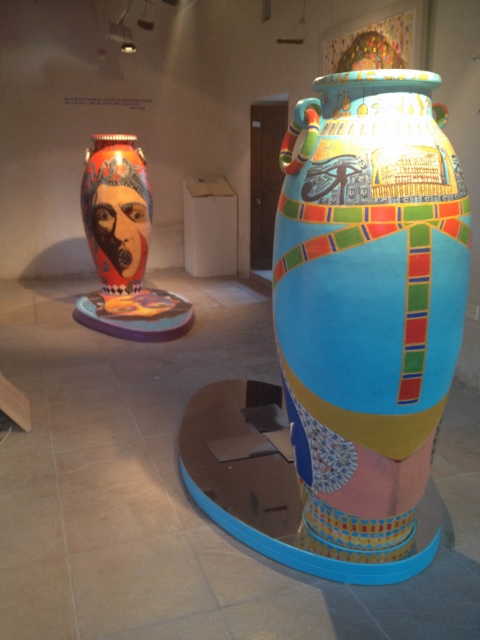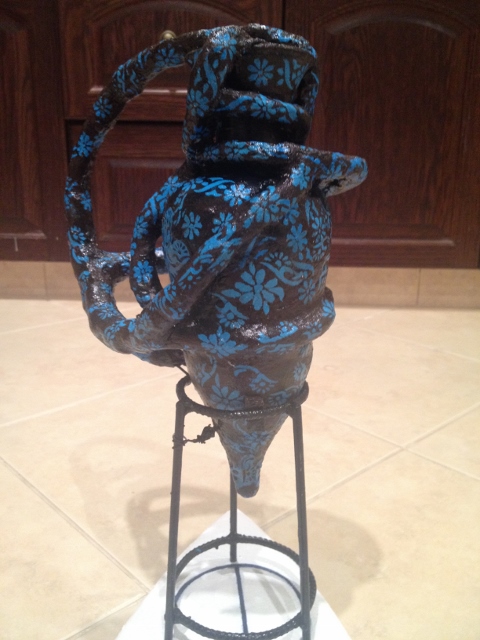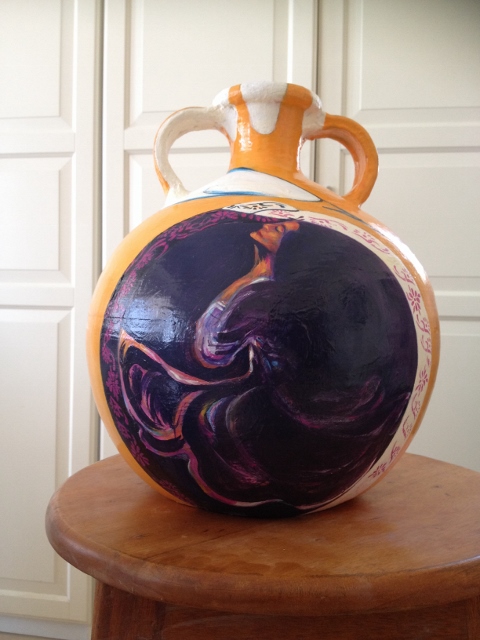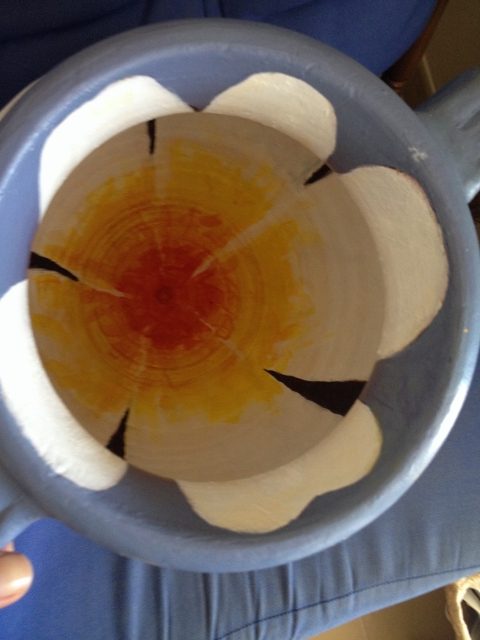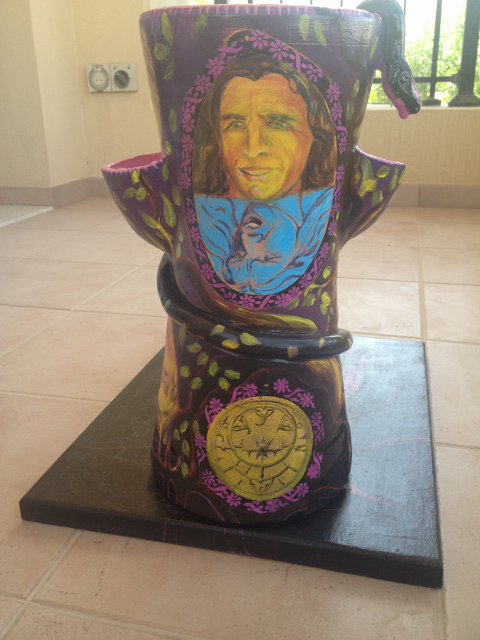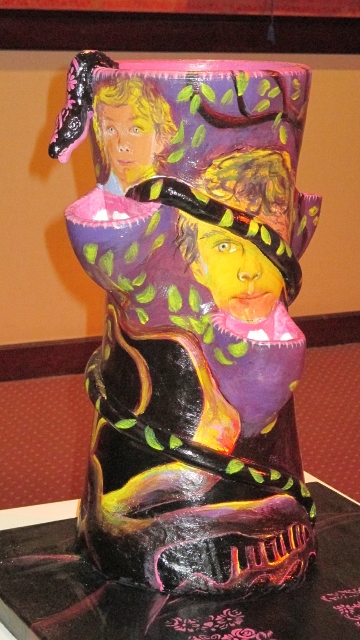The Beauty Art Project
(Oct 2012 to Jun 2014), the UAE
The Beauty project involved reflecting on my own personal experience of the events of my own life in relation to my identity as a Syrian and my ancient heritage. The project was born at a time when the horrors of war in my own country were affecting my regard for beauty. My questioning the nature of beauty revealed that the ugly existed alongside the sublime to generate beauty. I developed my artwork practice upon jars, fascinated that the mythical Medusa was regarded positively in Byzantium, but despised and feared in Hellenic Greece.
BEAUTY 1
“I saw a busy potter by the way
Kneading with might and main a lump of clay;
And, lo! the clay cried, “Use me gently, pray;
I was a man myself but yesterday!”
/Omar Al Khiam/
My interest in painting upon jars stems from my high respect for the traditional craft of pottery which is both artistic and functional. I see the jar deeply connected to the stories of mythology and my own Syrian heritage. I wanted to give a voice to the jar by setting a story upon its surface. The result is a three jar series with a narrative based upon Hanna Segal’s
My interest in painting upon jars stems from my high respect for the traditional craft of pottery which is both artistic and functional. I see the jar deeply connected to the stories of mythology and my own Syrian heritage. I wanted to give a voice to the jar by setting a story upon its surface. The result is a three jar series with a narrative based upon Hanna Segal’s writing on beauty:
“We may find that something is pretty but not beautiful unless the dark side of life also is taken into account, albeit unconsciously”.
Segal also writes that “there is also a counterbalancing of the violence by its opposite in the form,” a universal theme that opposites complement each other. Beauty 1 is a painting of my impression of ugliness, rendering the form of Carravagio’s Medusa upon a traditional large pot, in the Hellenic style and colour, using Italian egg tempera and acrylic colours. In opposition I present the celebrated Syrian queen, Zenobia, as a shadow cast along the wooden base that supports the jar.
I am using mythological symbols from Greece, Turkey and Syria. The snake features in ancient religion, mythology and literature as the creature admired and feared for its creative life force, its ability to transform and its powers of healing. So, whilst I represent ugliness in the shape of Medusa, the once beautiful but forever evil pariah, albeit highly respected, the writhing snakes may not actually be bringing an additional force of ugliness; there may actually be a positive element in their presence, yet another paradox! In the shadow of Medusa’s ugliness I have painted the beautiful face of Zenobia, clever and brave. The 3rd Century Syria that Queen Zenobia controlled was at a peak of civilisation. Whilst the stories of the two beauties contrast each other, they are both bound together by their respective downfalls.
According to legend Medusa was once a very pretty woman, but a goddess jealous of her beauty made her ugly with hair full of snakes. The sinister snake symbol, though, has an antithesis in ancient tradition and religion. It was actually a symbol of fertility, rebirth, even eternal life. The snake would adorn the crown of ancient pharaohs.
My research into the two stories/myths involved travel in Greece and Turkey, just as much as reference to my Syrian heritage. For the purpose of the project I place the Greek myth of Medusa as representative of the west, mindful of course that Medusa had a positive connotation for the Roman and even Byzantine civilizations, the latter being an ‘eastern’ civilization, even. Historically, Zenobia is an important Syrian character who came into conflict with the Roman Empire.
BEAUTY 2
My interest in painting upon jars stems from my high respect for the traditional craft of pottery which is both artistic and functional. I see the jar deeply connected to the stories of mythology and my own Arab heritage. Upon the second pot, Beauty 2, I am trying to capture the peaceful, calm and assured face of the legendary Egyptian queen, Nefertiti.
Nefertiti was the royal wife of the Egyptian Pharaoh Akhenaten and the two of them ruled their kingdom at a time of great wealth. Such was the power they enjoyed that they even lead a religious revolution introducing the worship of a single god, Aten.
Nefertiti rests upon a mirror that unlike Beauty 1 still reflects the exact image of her beauty. The queen’s beauty remains intact, yet as we take a glimpse at her reflection we see ourselves and others. We ask ourselves, does our own beauty and assuredness match that of the queen so regal upon what is actually a functionally simple pot? To bring my Nefertiti down to earth a bit I have added an inner sheet of mirror to disrupt her beauty. Nefertiti is actually as human as the rest of us! In terms of artistic technique, Picasso would begin with beauty and then break it up to create ugliness. This connection between ugliness and beauty is also present in the world of psychoanalysis. As we have seen in Beauty 1, beauty can stem from ugliness. Refering to Hanna Segal once again: “The ugliness of the breaking up and devastation is transformed into an object of beauty”.
There is one other aspect of beauty I am trying to express here: that of the universality of the notion of beauty. We are mesmerized by the actual sculpture of the famous queen. The style of her beauty really has not changed at all over the thousands of years, just as the functional utility of the earthen pot has remained unchanged.
Music
The background music I would play during the project is the work of Malek Jandali, a Syrian composer and pianist. He has performed music based on ancient Ugaritic Hurrian songs which were composed upon clay tablets discovered in Ugarit, Ras Al Shamra, in Syria. The songs are thought to be the oldest notated music.
BEAUTY 3 - I was a man myself but yesterday
The title of this piece comes from a line from an Omar Al Khiam poem.
“And, lo! the clay cried, “use me gently, pray; I was a man myself but yesterday”.
This work is a summary of my reflections upon my reading of the following books: Brian Clegg’s the Universe Inside Me, AT Mann’s the Round Art of Astrology and Derek & Julia Parker’s the New Complete Astrologer. The poems of Omar Khiam connect strongly with many of the conclusions expressed by Clegg in his 2012 book on the science of the human body.
The pot symbolises the woman’s body and in particular her womb. The wooden base portrays a number of astro-scientific ideas. There is the Einsteinian curved universe upon which I have drawn stylised representations of a Da Vinci Vitruvian man and woman. Upon the woman I have depicted the seven chakra colours. The sketch in the middle is half man, half woman representing the third hermaphrodite sex.
I am using in the three pots vibrant colours that push the relationship between colour forms and the three dimensions.
Ouroboros, the snake that bites its own tail, surrounds the lip of the pot. This snake is the shining or illuminating body that dwells in the heart of man and which also symbolises the universe. Upon this snake I have included the astrological symbols for the planets. Another snake surrounds a glass, a symbol ancient in origin but contemporary in its use as the symbol for pharmacy. Below the neck of the pot I depict the snake statue from Mt Nebo in Jordan, representing the prophet Moses. Also on the neck of the pot I depict Ugaritic cuneiform letters taken from the Epic of Gilgamesh poem, the oldest poem in history.
The unity of the circle concept comes from ancient history connecting the past, the present and the future. Einstein connected space and time, integrating time with space in his theory of the fourth dimension. Space has three dimensions: up and down, forward and back, and side to side. You can move in any one of these directions. Time in the fourth dimension, though, can only be moved through in a forward direction. Einstein thought that space time is curved. If this is true, the distance to the past or to the future could be shorter than it seems.
BEAUTY 4
“Both Light and shadow are the dance of love.”
Rumi
BEAUTY 5
In much of my recent art work I have depicted the snake biting its tail. The ouroboros symbol represents the cyclical renewal of life into infinity. It represents the cycle of life, death and rebirth, leading to immortality. It can also represent the idea of primordial unity related to something existing in or persisting before any beginning.
Sufi philosophy is connected to the ouroboros, acted out in the swirling dance, one hand pointed to the universe and the other to the ground. This swirling around in the Sufi dance also creates the shape of a lotus.
BEAUTY 6
What is the heart? A flower opening.
Rumi
BEAUTY 7
The shape of the pot goes back to 3500 BC in Syria. It is one of the shapes of the goddess Astarte. The snake, the three cups on the body of the pot relate to the body of Astarte. The design is the original symbol of what pharmacies use now: the cup and the snake, or the cross and the snake. Yes, it is me feeling happier inside the pot separated from the outside surrounding world; my son, my husband with their happy and difficult times. The snake is connected to me, sliding outside the pot and around my son trying to protect him. I painted Xavier in his three stages of his growth. However, his portrait with the opposite reflects his mood. My husband also has a reflection of his other face. The snake biting its tail, as ouroboros, surrounds him.
I have also included an Arab astrolabe! The mangrove tree is on the wooden base and the pot to go inside the pot is connected to me. The designed hands with two different coloured flowers on fingers relate to the marriage rings. I am trying to connect ugliness with beauty as we all have our ugly and beautiful sides. Hanna Segal’s writes on beauty:
“We may find that something is pretty but not beautiful unless the dark side of life also is taken into account, albeit unconsciously.”



